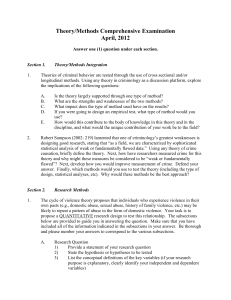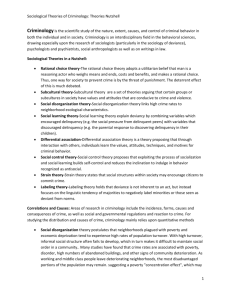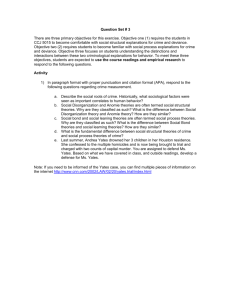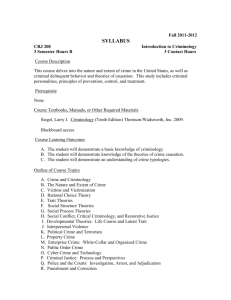sample syllabus - Salem State University
advertisement
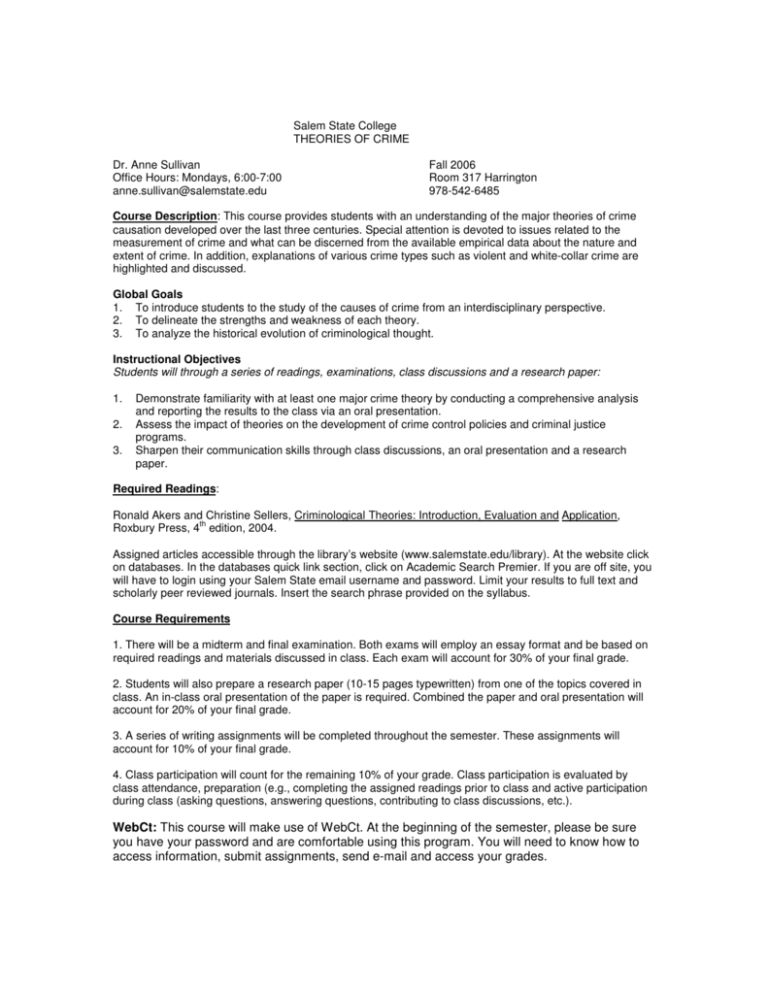
Salem State College THEORIES OF CRIME Dr. Anne Sullivan Office Hours: Mondays, 6:00-7:00 anne.sullivan@salemstate.edu Fall 2006 Room 317 Harrington 978-542-6485 Course Description: This course provides students with an understanding of the major theories of crime causation developed over the last three centuries. Special attention is devoted to issues related to the measurement of crime and what can be discerned from the available empirical data about the nature and extent of crime. In addition, explanations of various crime types such as violent and white-collar crime are highlighted and discussed. Global Goals 1. To introduce students to the study of the causes of crime from an interdisciplinary perspective. 2. To delineate the strengths and weakness of each theory. 3. To analyze the historical evolution of criminological thought. Instructional Objectives Students will through a series of readings, examinations, class discussions and a research paper: 1. 2. 3. Demonstrate familiarity with at least one major crime theory by conducting a comprehensive analysis and reporting the results to the class via an oral presentation. Assess the impact of theories on the development of crime control policies and criminal justice programs. Sharpen their communication skills through class discussions, an oral presentation and a research paper. Required Readings: Ronald Akers and Christine Sellers, Criminological Theories: Introduction, Evaluation and Application, th Roxbury Press, 4 edition, 2004. Assigned articles accessible through the library’s website (www.salemstate.edu/library). At the website click on databases. In the databases quick link section, click on Academic Search Premier. If you are off site, you will have to login using your Salem State email username and password. Limit your results to full text and scholarly peer reviewed journals. Insert the search phrase provided on the syllabus. Course Requirements 1. There will be a midterm and final examination. Both exams will employ an essay format and be based on required readings and materials discussed in class. Each exam will account for 30% of your final grade. 2. Students will also prepare a research paper (10-15 pages typewritten) from one of the topics covered in class. An in-class oral presentation of the paper is required. Combined the paper and oral presentation will account for 20% of your final grade. 3. A series of writing assignments will be completed throughout the semester. These assignments will account for 10% of your final grade. 4. Class participation will count for the remaining 10% of your grade. Class participation is evaluated by class attendance, preparation (e.g., completing the assigned readings prior to class and active participation during class (asking questions, answering questions, contributing to class discussions, etc.). WebCt: This course will make use of WebCt. At the beginning of the semester, please be sure you have your password and are comfortable using this program. You will need to know how to access information, submit assignments, send e-mail and access your grades. Week Topic Sept. 11 Introduction and Overview of the Course What is Criminology The History of Criminology What Criminologists Do: The Criminological Enterprise Sept. 18 Criminological Data and the Correlates of Crime The Uniform Crime Reports The National Incident Based Reporting System Self-Report Studies Victim Surveys Crime Patterns: Age, Gender, Race and Social Class Readings Chapter 1 The National Incident-Based Reporting System: Research and Policy Applications. By: Maxfield, Michael G., Journal of Quantitative Criminology, June 1999, Vol. 15 Issue 2, 119-149. (Search, national incident based reporting system). Sept. 25 Classical and Rational Choice Theory Chapter 2 Classical Theory: Jeremy Bentham and Cesare Beccaria Rational Choice and Routine Activities Theory Eliminating Crime: General Deterrence, Specific Deterrence and Retribution Defensible Space (CPTED) Does the Perceived Risk of Punishment Deter Criminally Prone Individuals? Rational Choice, Self Control and Crime. By: Wright, Bradley R.E.; Caspi, Avshalom; Moffitt, Terrie E.; Paternoster, Ray. Journal of Research in Crime & Delinquency, May 2004, Vol. 41 Issue 2, 180-213. (Search rational-choice and crime) The Impact of the Built Environment on Crime and Fear of Crime in Urban Neighborhoods. By: Schweitzer, John H.; Kim, June Woo; Mackin, Juliette R.. Journal of Urban Technology, December 1999, Vol. 6 Issue 3, 59-73. (Search, defensible space theory) Oct. 2 Biological Theories Physical Type Theories: Lombroso and Sheldon Mental Deficiency: Feeblemindedness and Intelligence Genetic Influences: Heredity and Twin Studies Current Theories: Mental Disorder Chapter 3 Heredity and Sociological Theories of Deliquency: A Reconsideration. By: Rowe, David C.; Osgood, D. Wayne. American Sociological Review, August 1984, Vol. 49 Issue 4, 526-540. (Search genetic theory and crime) Oct. 13 Psychological Theories Social Learning Theory Cognitive theory Personality and Crime Chapter 4 Oct. 16 Social Disorganization Theories Chapter 8 The Work of Shaw and Mckay Transitional Neighborhoods, Community Deterioration The Correlates of Disorganization: Poverty, Heterogeniety, Residential Mobility, Density and Family Disruption Replicating Sampson and Groves's Test of Social Disorganization Theory: Revisiting a Criminological Classic. By: Lowenkamp, Christopher T.; Cullen, Francis T.; Pratt, Travis C.. Journal of Research in Crime & Delinquency, November 2003, Vol. 40 Issue 4, 351-373. (Search social disorganization theory) Oct. 23 Anomie and Strain Theories The Work of Emile Durkheim and Robert Merton Strain and Criminal Careers Differential Opportunities Chapter 8 Anomie and Strain: Context and Consequences of Merton's Two Theories. By: Featherstone, Richard; Deflem, Mathieu. Sociological Inquiry, November 2003, Vol. 73 Issue 4, 471-489. (Search strain theory and crime) Oct. 30 Mid-term Examination Nov. 6 Cultural Deviance and Subcultural Theories Conduct Norms and Focal Concerns The Formation of Deviant Subcultures: Gangs Middle-Class Measuring Rods A Systematic Analysis of the Dynamics and Organization of Urban Street Gangs. By: Ruble, Nikki M.; Turner, William L.. American Journal of Family Therapy, June 2000, Vol. 28 Issue 2, 117-132. (Search street gangs) Nov. 13 Social Learning Theories Differential Association Differential Reinforcement Neutralization Theory Chapter 5 Applying Social Learning Theory to Police Misconduct. By: Chappell, Allison T.; Piquero, Alex R.. Deviant Behavior, March 2004, Vol. 25 Issue 2, 89-108. (Search social learning theory and crime) Nov. 20 Social Control Theories Family and Peer Relations and Educational Experiences Containment Theory Chapter 6 Does Dropping Out of High School Cause Deviant Behavior: An Analysis of the National Education Longitudinal Study. By: Drapela, Laurie A.. Deviant Behavior, January 2005, Vol. 26 Issue 1, 47-62. (Search social control theory and crime) Nov. 27 Labeling Theories Crime and Labeling Theory Becoming Labeled: Primary and Secondary Deviance Chapter 7 Gender, Reflected Appraisals, and Labeling: A Cross-Group Test of an Interactionist Theory of Delinquency. By: Bartusch, Dawn Jeglum; Matsueda, Ross L.. Social Forces, September 1996, Vol. 75 Issue 1, 145-176. (Search labeling theory and crime) Dec. 4 Conflict and Radical Theories Feminist Theory Power-Control Theory Economic Marginalization Radical Feminism: Patriarchy and Crime Dec. 11 Presentations Dec. 18 Final Examination Chapters 9 and 11 Paper Guidelines: Select a theory that interests you. The paper should be organized as follows: 1. Summarize the theory in terms of its major tenets. 2. Evaluate the theory relative to whether it provides a sound explanation of crime. Does it have clearly defined concepts? Are its propositions logical? Does it account for a wide range of criminal behavior? Or is it narrow in scope? Can the theory be verified or disproved by empirical evidence? Does the theory have empirical validity? Has been supported by research evidence? 3. Find three research articles that have been published in professional refereed journals testing the theory. Briefly describe each article including the method used, the hypotheses or questions addressed, the major findings and conclusions. Collectively, do the findings from the research provide strong or weak support for the theory? 4. Lastly, what are the criminal justice policy implications of the theory? What type of programs or strategies would the theory indicate are needed to reduce crime? Recommended Journals: Criminology, Crime & Delinquency, Criminal Justice & Behavior, Justice Quarterly, Journal of Criminal Justice, Journal of Quantitative Criminology and Journal of Research in Crime & Delinquency. Format Guidelines: The paper should be between 10 and 15 pages. Use a font no larger than 12 points and 1 inch margins. Use the APA’s citation style. Some APA citation guidelines: Text: Citations of authors within a sentence take the form "Freud (1928) contended that...." with the year in parenthesis. Sentences not mentioning the author's name put the entire citation in parentheses: "...according to social learning theory (Bandura & Walters, 1962)". Each author's work cited in the report must be listed in the reference section, in alphabetical order. Text: Following, or before each quotation (even an indented one) or a statement specific enough to need a reference, the citation is placed in parentheses, with the author's name, followed by the year of publication of the work quoted or referred to, and the page or pages cited, thus: (Klein 1988:122), (Rowe 1993: 115-119), or (Smith, et. al., 1991: 2122). If the author of the quotation is clear from the text, then the sentence concluding the reference should cite the year of publication and the page(s). References Cited: The text and notes are followed by References Cited--which do not include any publication not cited in the text; the list is not a bibliography. The list should begin on a separate page, and all entries must be single-spaced, (double spacing between entries), listed alphabetically by last name and senior author, and chronologically for two or more titles by the same author(s). Schmeiser, David A. (1988). The Native Offender and the Law. Ottawa: Law Reform Commission of Canada. Turk, A.T. (1996) "Law, Conflict and Order: From Theorizing Toward Theories". Canadian Review of Sociology and Anthropology 23(3) 282-294. The entries have the following elements: author(s); year of publication; title; and source (i.e., publisher and place of publication in the case of books and reports only). Book titles are underlined; titles of articles are enclosed with double quotation marks; journal titles are underlined. The journal title is followed by the volume number, then the number within the volume (or the month or season, depending upon the journal's style), and then the page numbers. In-Class Presentation You will also be required to present your paper to the class near the end of the semester. Your presentation should be organized. You should utilize power point, transparencies or the whiteboard. You may want to prepare handouts to distribute to the class. Plan on making a 15 minute presentation with an additional five minutes set aside for questions and comments. The presentations are scheduled for the last two class meetings.


